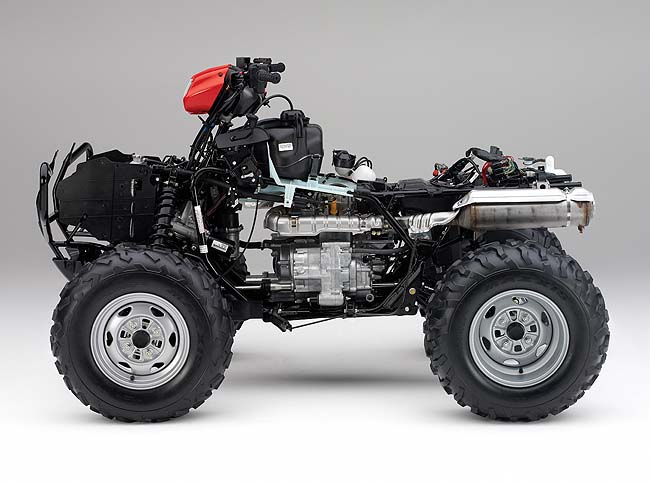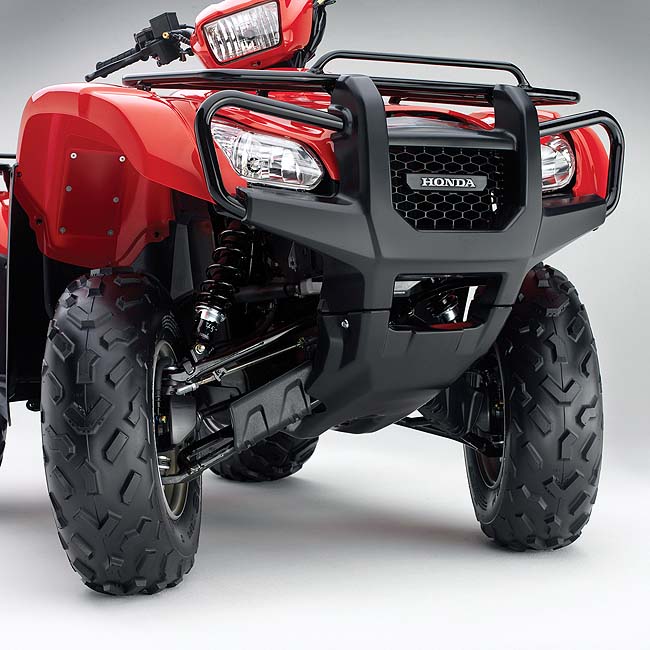TEST: 2012 HONDA FOREMAN 500

“Description: four-wheel drive machine with a transverse engine derived from some sort of motorcycle. Continuously variable transmission. Approach cautiously, may be armed with a dif lock.” That could be any one of a dozen quads.
Of course, if the perp were a Honda 500 Foreman, there would be no doubt who done it: “Four-wheel drive quad with a longitudinal crank, push-button transmission, straight axle and no diff lock. May disguise itself as a sport ATV.” There’s only one machine in the world that meets that description. An APB would go out immediately for the Foreman.
Honda likes to be very different when it comes to utility quads. The formula is set in stone for virtually all other ATV makers. You start with some sort of motorcycle engine–or at least use a design inspired by a motorcycle. For 500cc quads, that usually means a liquid-cooled, four-valve single with the crankshaft running crossways. In a couple of cases the motor might be a twin. The power will have to be channeled through a CV transmission and so on and so forth. Most of them even look alike.
But back in 1995, Honda tore up the police sketch and invested in a very different design. Honda engineers started thinking in more automotive terms. The crankshaft was turned to run lengthwise, which made more sense given that the final drive would be through front and rear shafts oriented the same way. The evolution of Honda’s utility ATVs continued to take its own path over the years. And in the case of the Foreman 500 4×4, 2012 marks a big change in the machine’s history.
A PLACE OF MY OWN
Honda’s line is confusing to most on-lookers. When the 450 Foreman was released in 1998, it was the top of the line. But within a few years, it had to live in the narrow space between the 420cc Rancher and the 500cc Rubicon in terms of price and complexity. The lines of division became more blurry back in 2005, when the Foreman got a boost in displacement (from 450 to 475cc) and Honda started calling it a 500. Thus, there were two completely different TRX500s in the line. The Rubicon was still more sophisticated with liquid-cooling, four valves and a fully automatic transmission.
This year the distinction between the two models is very, very fine. The Foreman gets a new motor with liquid-cooling and electronic fuel injection. The Rubicon will be back with a CV carb and the option of a fully automatic transmission. Despite the upgrades, the smaller Foreman also keeps a price advantage. It has a base price of $6899. That buys you the new motor and EFI with a five-speed, manual gearbox and an automatic clutch. For $200 more, the ES model has all the same stuff plus push-button electric shifting. Power steering adds another $600 to the price tag, which comes to $7699 if you want it all.
Honda engineers put substantial effort into the Foreman for 2012. The motor is new from the crankshaft up. The liquid-cooling allowes an increase in compression ratio, which brought an increase in torque. It remains a pushrod motor with two valves. That means that checking the valve clearance is still a 10-minute job. It also got upgraded suspension, a slightly shorter wheelbase and new bodywork for 2012. The rear end, in particular, received serious attention. The original design dated back to the ‘90s and had two very basic shocks connected to a steel swingarm and a straight axle. Now, a more substantial single shock does all the work. Honda also upgraded the front shocks to match the rear.
THE FAB FORE
In broad terms, it’s still the same core machine: a torquey 4×4 with a straight-axle rear end. It clearly walks the Honda line–the company has a very distinct way of looking at utility quads. Under the racks and trappings of a work machine, there’s a hint of sportiness. Honda tries to make all its 4x4s light and compact, with easy handling the highest priority. This year the Foreman is even more compact than previously. The new bodywork and the shorter wheelbase underscore the fact that Honda doesn’t the machine to be intimidating. In a market that is becoming more and more crowed with massive ATVs, the Honda feels light and maneuverable. That’s the defining characteristic about this quad, and that‘s what makes it more inviting for short work jobs as well as for long fun rides. The Foreman is one of our favorite quads for four-wheel-drive adventures in tight canyons and stream beds. You can get out of some pretty amazing situations just by using body English and the Honda’s super tight turning radius. Our one complaint hasn’t changed. We still would like a front differential lock to pull us out of the really ugly stuff.
Our Foreman was equipped with power steering. With a machine this seemingly small, you might be temped not to spend the additional dough. But once you ride a quad with power steering, it’s hard to go back. Honda’s version of EPS is one of our favorites for several reasons. First, it offers more assist at low speed than at high speed. That means that its easy to manhandle in the aforementioned tight canyons, but still perfectly stable at speed. Some others offer just as much assistance at high speed, the result being an uncomfortable degree of nervousness. And the price is right. An EPS equipped Foreman costs less than a base-model Can-Am 500 without power steering.
On the other hand, the Can-Am motor is probably the most powerful in the class.. The Honda definitely got a boost this year with liquid-cooling and more compression. It has more power right off the bottom and that’s certainly welcome. But the Foreman is no rocketship. It gets the job done without much thrill factor. The push-button gearbox compensates for that somewhat by giving you more control. When you’re running out of steam on a sandy hill, you either grind it out in a tall gear or bump it down to a lower gear with no more effort than it takes to beep a horn. A CV transmission, on the other hand, drones monotonously in the same situation, giving you no options and making all the decisions for itself. Even more importantly, there’s no belt in the Honda transmission. That eliminates the number one source of mechanical failure. In extreme mud and sand, belts can heat up and break, leaving you completely stranded. On the negative side, you still have to shift. The Foreman is torquey enough to leave in third gear most of the time, but only if the ground is level and firm. It’s easy to just plain forget that you have to shift when conditions change, even if it requires no more effort that pushing a button or (on the manual version) clicking a shifter. Again, the additional price that Honda asks for push-button shifting is so little, we don’t know why you wouldn’t go for it.
LIFE IN THE RED LANE
When it comes to creature comforts, the Foreman doesn’t go overboard with gadgetry. The new seat is definitely cushier and there’s a new digital instrument panel this year with gear position, speed and fuel level displayed in a large way. There’s a small cubby and three decent halogen headlights. As delivered, the machine is a little under-equipped, perhaps, but Honda has an accessories division that can deliver anything from a winch ($550) to cargo boxes ($180 front, $250 rear).
That what we like about the Foreman. It comes light and nimble, and you can build it into anything you please. It’s tough to go in the other direction. When an ATV starts as a battleship it will always be a battleship. This year, the changes to the Foreman might have made it more sophisticated, but it keeps its simple identity. That’s fine with us.

The Foreman remains friendly and unintimidating, even in unfriendly circumstances.

This year brings a number of big changes to the Foreman, the two most important of which are liquid-cooling and electronic fuel injection.

Despite the upgrades for 2012, the Foreman motor remains very simple in design. It’s a pushrod two-valver laid out with a longitudinal crankshaft. Very automotive.

What we love of about the Foreman is its compact, lightweight feel. The new bodywork makes it seem even smaller.

Honda’s take on power-steering is to only provide assistance when you need it most; at low speed.
Engine type … liquid-cooled, OHV, single-cylinder, 4-stroke
Displacement … 475cc
Bore & stroke … 92.0mm x 71.5mm
Fuel system … 36mm Keihin EFI
Starting … Electric (Optional recoil back up)
Transmission …5-speed push-button with automatic clutch & reverse
Final drive … Shafts
Suspension/Wheel travel
Front: Dual A-arms w/ 6.7″
Rear: Swingarm w/6.9″
Brakes
Front…Dual hydraulic discs
Rear…Sealed drum
Tires
Front…25 x 8-12
Rear…25 x 10-12
Length/Width/Height…83.7″/47.4″/47.4″
Seat height…34.7″
Ground clearance… 7.6″
Wheelbase…50.4″
Fuel capacity…4.0 gal
Curb weight…626 lb. *
Colors…Red, Olive, Camo
Price…$7699
Importer … American Honda; (310) 783-2000



Comments are closed.